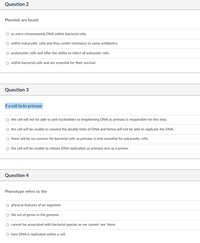
Human Anatomy & Physiology (11th Edition)
11th Edition
ISBN: 9780134580999
Author: Elaine N. Marieb, Katja N. Hoehn
Publisher: PEARSON
expand_more
expand_more
format_list_bulleted
Concept explainers
Question

Transcribed Image Text:Question 2
Plasmids are found
as extra-chromosomal DNA within bacterial cells.
within eukaryotic cells and they confer resistance to some antibiotics.
O prokaryotic cells and offer the ability to infect all eukayotic cells.
O within bacterial cells and are essential for their survival.
Question 3
If a cell lacks primase
O the cell will not be able to add nucleotides to lengthening DNA as primase is responsible for this step.
the cell will be unable to unwind the double helix of DNA and hence will not be able to replicate the DNA.
there will be no concern for bacterial cells as primase is only essential for eukaryotic cells.
O the cell will be unable to initiate DNA replication as primase acts as a primer.
Question 4
Phenotype refers to the
physical features of an organism.
O the set of genes in the genome.
cannot be associated with bacterial species as we cannot 'see' them.
O how DNA is replicated within a cell.
Expert Solution
This question has been solved!
Explore an expertly crafted, step-by-step solution for a thorough understanding of key concepts.
Step by stepSolved in 2 steps

Knowledge Booster
Learn more about
Need a deep-dive on the concept behind this application? Look no further. Learn more about this topic, biology and related others by exploring similar questions and additional content below.Similar questions
- No explanation needed just the letter of correct answer 2. DNA in cells is damaged: a) Millions of times a day. b) By collisions with other molecules or by chemical accidents and radiation. c) Not very often¸ and by radiation only. d) a and b 3. For genes that code for proteins, which molecule conveys the information from the gene to the ribosome? a) DNA b) mRNA c) tRNA d) rRNA 4. Which of the molecules below is produced during replication? a) mRNA b) rRNA c) tRNA d) DNA 5. Why is there a difference between the synthesis of a lead strand and that of a discontinuous strand in DNA molecules? a) The origins of replication are found only at end 5' of the molecule. b) Helicase and protein factors act at the extremity of 5'. c) DNA polymerases can only add new nucleotides at the extremity 3' a strand in the process of synthesis. d) DNA ligase only works in the 3' ; direction towards 5'. 6. Which of the following statements does not apply to a codon? a) It is made up of three nucleotides. b)…arrow_forwardExplain why both ssDNA and RNA are single strands, but there is a difference in concentration. (Using spectrophotometer)arrow_forwardVIRUS why do they steal cell membranes why are they not considered alivearrow_forward
- Viral chromosomes exist in a variety of conformations and can be made up of ________. Group of answer choices DNA or RNA DNA Main chromosomes and plasmids Protein coats and plasmids RNAarrow_forwardWhich statement is false regarding plasmids? Circular dsDNAs that reside in bacterial cells Replicate independently from host cell Encode no more than 1-2 genes that benefit the host cell Called episomes when they incorporate into the host cell genome Classified by what type of host cell they infectarrow_forwardPolymerase chain reaction cannot amplify complete circular plasmids. True Falsearrow_forward
- In the original F+ cell, newly synthesized _________ replaces the single strand transferred to the previously F− cell.arrow_forwarddescribe F plasmidarrow_forwardAll of the following could transfer antibiotic resistance genes during horizontal gene transfer EXCEPT transposons chromosomal DNA ribosomes O conjugative R plasmidsarrow_forward
arrow_back_ios
arrow_forward_ios
Recommended textbooks for you
 Human Anatomy & Physiology (11th Edition)BiologyISBN:9780134580999Author:Elaine N. Marieb, Katja N. HoehnPublisher:PEARSON
Human Anatomy & Physiology (11th Edition)BiologyISBN:9780134580999Author:Elaine N. Marieb, Katja N. HoehnPublisher:PEARSON Biology 2eBiologyISBN:9781947172517Author:Matthew Douglas, Jung Choi, Mary Ann ClarkPublisher:OpenStax
Biology 2eBiologyISBN:9781947172517Author:Matthew Douglas, Jung Choi, Mary Ann ClarkPublisher:OpenStax Anatomy & PhysiologyBiologyISBN:9781259398629Author:McKinley, Michael P., O'loughlin, Valerie Dean, Bidle, Theresa StouterPublisher:Mcgraw Hill Education,
Anatomy & PhysiologyBiologyISBN:9781259398629Author:McKinley, Michael P., O'loughlin, Valerie Dean, Bidle, Theresa StouterPublisher:Mcgraw Hill Education, Molecular Biology of the Cell (Sixth Edition)BiologyISBN:9780815344322Author:Bruce Alberts, Alexander D. Johnson, Julian Lewis, David Morgan, Martin Raff, Keith Roberts, Peter WalterPublisher:W. W. Norton & Company
Molecular Biology of the Cell (Sixth Edition)BiologyISBN:9780815344322Author:Bruce Alberts, Alexander D. Johnson, Julian Lewis, David Morgan, Martin Raff, Keith Roberts, Peter WalterPublisher:W. W. Norton & Company Laboratory Manual For Human Anatomy & PhysiologyBiologyISBN:9781260159363Author:Martin, Terry R., Prentice-craver, CynthiaPublisher:McGraw-Hill Publishing Co.
Laboratory Manual For Human Anatomy & PhysiologyBiologyISBN:9781260159363Author:Martin, Terry R., Prentice-craver, CynthiaPublisher:McGraw-Hill Publishing Co. Inquiry Into Life (16th Edition)BiologyISBN:9781260231700Author:Sylvia S. Mader, Michael WindelspechtPublisher:McGraw Hill Education
Inquiry Into Life (16th Edition)BiologyISBN:9781260231700Author:Sylvia S. Mader, Michael WindelspechtPublisher:McGraw Hill Education

Human Anatomy & Physiology (11th Edition)
Biology
ISBN:9780134580999
Author:Elaine N. Marieb, Katja N. Hoehn
Publisher:PEARSON

Biology 2e
Biology
ISBN:9781947172517
Author:Matthew Douglas, Jung Choi, Mary Ann Clark
Publisher:OpenStax

Anatomy & Physiology
Biology
ISBN:9781259398629
Author:McKinley, Michael P., O'loughlin, Valerie Dean, Bidle, Theresa Stouter
Publisher:Mcgraw Hill Education,

Molecular Biology of the Cell (Sixth Edition)
Biology
ISBN:9780815344322
Author:Bruce Alberts, Alexander D. Johnson, Julian Lewis, David Morgan, Martin Raff, Keith Roberts, Peter Walter
Publisher:W. W. Norton & Company

Laboratory Manual For Human Anatomy & Physiology
Biology
ISBN:9781260159363
Author:Martin, Terry R., Prentice-craver, Cynthia
Publisher:McGraw-Hill Publishing Co.

Inquiry Into Life (16th Edition)
Biology
ISBN:9781260231700
Author:Sylvia S. Mader, Michael Windelspecht
Publisher:McGraw Hill Education